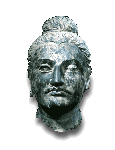
|
ARH 382 |

|
ARH 382 |
 |
>> | ID Lists | >> | ID List 12 |
Places
Balkh Was once the capital of ancient Bactria and the Islamic Abbasid and Samanid dynasties when it gained the noted appellation of the “Mother of Cities.” Balkh was destroyed during the Mongol Period and resurrected during the Timurid Period. It is now a village in present-day northern Afghanistan (near Mazar-I Sharif). Bezeklik City of the northern Silk Road around the Turfan Basin. Bukhara A city with a tremendous history. We met Bukhara earlier as one of the more important city-states of Sogdia. It was captured by the Arabs in 709, was the Samanid capital during the 9th – 10th centuries, and under Mongol, then Timurid control. Along with Samarkand, Bukhara is one of the historical and spiritual centers in present-day Uzbekistan. Karakorum Capital of the Mongol Empire established by Genghis Khan in 1220. The capital also went by the name “Erdeni Dzu” which is the Mongolian name for Buddha and the name of the site’s monastery. Mecca City of the Prophet Muhammad’s birth located in present-day Saudia Arabia. Location of the Kabbah to which all Muslims ritually orient themselves in prayer. Medina City in which the Prophet Muhammad began preaching the word of Allah. Samarkand A city with a tremendous history. We met it earlier as a city captured by Alexander the Great (329 BCE) and the capital of Sogdia (3rd – 8th c. CE). Samarkand was destroyed during the Mongol Period and resurrected during theTimurid Period. Along with Bukhara, Samarkand is the intellectual and spiritual center of current-day Uzbekistan. Turfan Basin Located at the eastern-most extension of the Tien Shan Mountains in the Uighur Autonomous Republic. It was geologically formed by the shifting of massif plates and is the deepest trough under sea level (505 ft/154 m) in the whole of China. People and Empires
Uighur Empire (745 – 854) Controlling the Tarim Basin area, the Turkic-speaking Uighurs of Mongolia established and empire. The empire actually moved after the mid-ninth century, establishing itself in the Gansu corridor for a time and then to Mongolia and back to the Tarim Basin area. Umayyad Dynasty (661 – 750) The first Islamic dynasty centered in Damascus (present-day Syria) and named after its ruling family known for its success as merchants. Seljuq Dynasty (1038 – 1194) The first Islamic dynasty formed by Turks from the steppe lands of Central Asia. Mongol Empire (1206 – 1368) The largest land empire the world has ever known. Genghis Khan (1167 – 1227) Also known as Temujin. In 1206 appointed himself through the power of the sky god – kok tengri, as the first great khan (king) of the Mongol Empire. Timurid Dynasty (1405 – 1506) Timur (1336 – 1405) – also known as Timur Lenk (“Timur the Lame) or Tamerlane. Charismatic founder of the Dynasty named after him and continued by his sons. After the passing of the great Mongol Empire, he believed himself the rightful heir and proceeded to accumulate former Mongol territory through severe military campaigns. Timur established his capital at Samarkand. The Four Dynasties of the Mongol Empire and their founders
- Yuan Dynasty (1206 – 1368) China Kublai Khan (1215 – 1294), grandson of Genghis
- Chagatai Dynasty (1227 – 1330) Central Asia Chagatai, second son of Genghis
- Ilkhanid Dynasty (1258 – 1353) Persia Hulagu (1217 – 1265), great grandson of Genghis
- The Golden Horde (1242 – 1480) Russia conquered by Batu (d. 1255), grandson of Genghis
Religions
- Islam:
- Islam – Lit. “submission, surrender (to the will of Allah).” Religion founded by the Prophet Muhammad in the seventh century on the Arabian Peninsula. Belief is center on one god, Allah.
- Allah – Lit. “god.” The sole god, the only true god of Islam.
- Koran – Lit. “reading, recitation.” The sacred book of Islam where the true word of god was revealed to the Prophet Muhammad.
- Manichaeism:
- Manichaeism – founded by the mystic Mani in the third century. The dualistic religion conceives of the world as a struggle between radical forces of good and evil. Manichaeism absorbed concepts parallel to it from Buddhism, Taoism and other religions it encountered as it spread. In the seventh century it reached Central Asia and in the eighth century was adopted by the Uighurs as a state religion.
- Mani – The “Apostle of Light” the founder of the religion named after him. He was born in Babylon (Iraq) and preached throughout Persia. A myth developed around him in artistic circles, naming him as one of the original geniuses of Persian manuscript painting. Those that believed in the myth, thought his paintings could be found in Serindia.
|